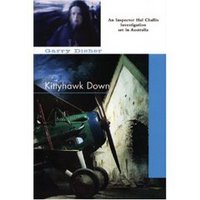
One of the pleasures of reading mystery and noir in translation is getting a glimpse of other cultures. In spite of the globalization of culture (and literature) there is still a strangeness to crime in other places, a difference in the atmosphere of the streets and the motivation of the criminals. Japanese noir is a glimpse into a culture that is particularly "other" in many ways. Miyuke Miyabe's first novel in translation, All She Was Worth, examines the particularities of Japanese notions of identity (particularly with respect to gender) and debt. The structure of the novel is a pretty straightforward investigation (albeit by a policeman who is not working officially). Miyabe's second novel to make it into English is Shadow Family, whose structure is a "one act play," as one of the characters remarks. The first several chapters are all indirect narrative, just a set up for the main event, which is a long, detailed presentation of an unual, theatrical interrogation scene. Ed McBain did this sort of thing occasionally in the 87th Precinct series, but this version more extended and with particularly Japanese sensibilities. But the major premise of the novel regards Internet identity, and the complex possibilities are really only touched on by Miyabe. The strains inherent in the Japanese family, and the consoling illusion of an "ideal" online family are examined in detail, but the gender-bending opportunities of online identity are not even suggested. Still, the novel is an interesting glimpse into dark corners of ordinary life in Japan.
 Out, by Natsuo Kirino, is a much darker vision of life (particularly women's lives) in the Japanese working class. Out displays the mundane lives of its characters, but with dark humor and open sexuality (elements missing from Miyabe's work). Out is a bit cartoonish but not necessarily in a bad way. It's a striking experience of the underside of another culture. An even darker ride is Ryu Murakami's In the Miso Soup, whic h takes the reader along on a guided tour of the Japanese sex trade.
Out, by Natsuo Kirino, is a much darker vision of life (particularly women's lives) in the Japanese working class. Out displays the mundane lives of its characters, but with dark humor and open sexuality (elements missing from Miyabe's work). Out is a bit cartoonish but not necessarily in a bad way. It's a striking experience of the underside of another culture. An even darker ride is Ryu Murakami's In the Miso Soup, whic h takes the reader along on a guided tour of the Japanese sex trade.  Murakami's earlier books in English, the amazing Almost Transparent Blue and the more straightforward Coin Locker Babies, are contemporary fiction more than they are noir per se. In the Miso Soup is very much in the noir tradition, from a peculiarly Japanese point of view. It is funny, very (VERY) dark, and has a more distinctive narrative voice that is much livelier than the narrators of Miyabe's books. Speaking of voice, there is frequently a stilted quality to the translations of Japanese mystery novels. That is true with Miyabe and Kirino (though not with Murakami, whose prose may be more global in some ways), as well as with some otherwise excellent mystery/noir novels by Akimitsu Takagi, including the excellent Tattoo Murder Case, whose considerable sensational elements are dampened a bit by the stilted quality of the English prose. These translation problems may be the result of the very different structures of the two languages in question, and present only a small hurdle to the enjoyment of these novels.
Murakami's earlier books in English, the amazing Almost Transparent Blue and the more straightforward Coin Locker Babies, are contemporary fiction more than they are noir per se. In the Miso Soup is very much in the noir tradition, from a peculiarly Japanese point of view. It is funny, very (VERY) dark, and has a more distinctive narrative voice that is much livelier than the narrators of Miyabe's books. Speaking of voice, there is frequently a stilted quality to the translations of Japanese mystery novels. That is true with Miyabe and Kirino (though not with Murakami, whose prose may be more global in some ways), as well as with some otherwise excellent mystery/noir novels by Akimitsu Takagi, including the excellent Tattoo Murder Case, whose considerable sensational elements are dampened a bit by the stilted quality of the English prose. These translation problems may be the result of the very different structures of the two languages in question, and present only a small hurdle to the enjoyment of these novels.



